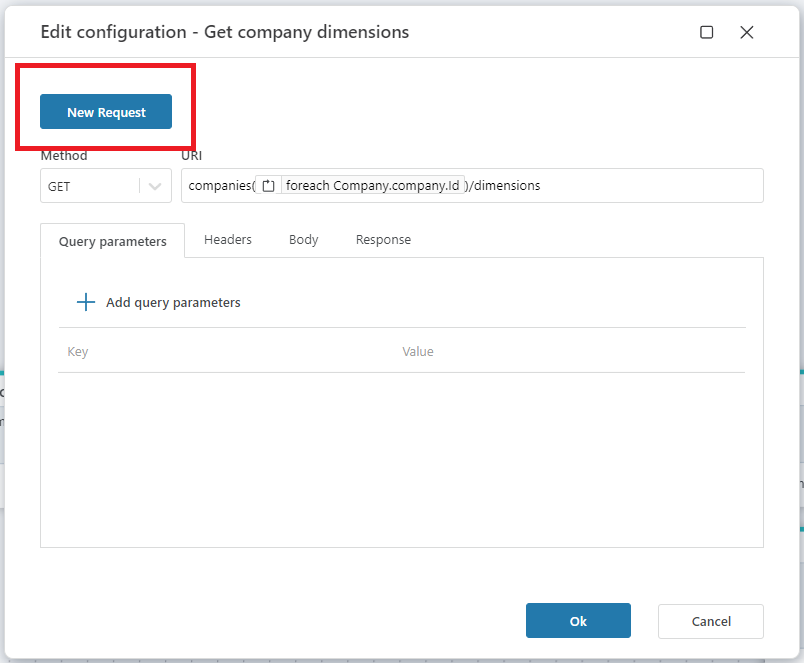REST API Request with paging
The REST API Request with paging action enables you to call Dynamics 365 Business Central v2 APIs and retrive large amounts of data. A typical use case is to create data integrations for pulling data from Dynamics 365 Business Central into a data platform solution.
Note
This action also works for APIs that does not return paged responses, in which case the response will contain only a single page.

Properties
| Name | Type | Description |
|---|---|---|
| Connection | Required | The Dynamics 365 Business Central connection used to make an authenticated request to the Dynamics 365 Business Central API. |
| Dynamic connection | Optional | Use this option of you needs to create a connection using credentials stored outside the workspace, for example in your own Azure SQL or PostgreSQL database. When this property is defined, Flow will use the Dynamic connection at runtime, and Connection only at design time. To dynamically create a connection, use the Create Dynamics 365 Business Central connection action. |
| Configuration | Required | Defines the HTTP request to make to the API. See details below. |
Returns
The return type is defined when configuring the action. It can be a custom data type or the raw JSON response from the API.
We recommend using the built-in HttpResponse<T> type because it will include additional information about the response, such as the HTTP status code and error(s).
We also recommend simply dumping the raw response to a data store, and then use data transformation tools to transform the data into a usable format. If you know the API returns small amounts of data (10 000 - 200 000 records), you can consider using the Get JSON DataReader to flatten JSON to a tabular format and process the data as rows and columns, for example by inserting directly to a SQL Server table.
Configuration
To define a request to the Business Central API, you can start from a template, or define it manually.
If you press the New Request button in the Configuration dialog, you can choose from a set of predefined request templates.
The Business Central API is large, so the template collection contains only a subset of the available APIs. If you cannot find a template for the request you want to make, you can refer to the Dynamics 365 Business Central v2 API documentation and define the request manually.

Defining a request manually
To define a request manually, please refer to the Dynamics 365 Business Central v2 API documentation to learn which endpoint and parameters to use.
- Define the
Method(GET,PUT,POST,DELETE, etc ). Most APIs for fetching data requires theGETmethod. - Define the
URI. This is the API endpoint, for examplecompanies(id)/accounts. If a query requires parameters (for example the company id in this example), insert a variable from Flow using the popup that appears when the URI editor gets focus. - Define the
Response. The default response type is HttpResponse<string>. This means you get back the raw JSON response from the API. You can change the data type to a custom type if you want to, but keep in mind that this will allocate more memory and impact performance negatively for large data sets such as dimensions and general ledger queries. We recommend simply dumping the raw response to a data store (like a database or blob storage), and then use tools like dbt, SQLMesh or Azure Data Factory to transform the data into a usable format.
Response paging
The REST API Request with paging action handles paging automatically for you, by returning one page at a time until the Dynamics 365 Business Central API returns no more pages. Note that this action also works for APIs that does not return paged responses, in which case the response will contain only a single page.
Error handling
If the response from the Dynamics 365 Business Central REST API is set to HttpResponse<T>, the response object includes an IsSuccess property. When IsSuccess is false, the response has an ErrorContent property that relay the error messages from the API call or from internally thrown exceptions.
For other response types and for severe errors, the action will raise an error that could terminate the Flow unless either the On Error port is connected, or it is wrapped in a Try-Catch action.
The On Error error handler will be triggered for each page error, allowing you to handle errors individually and preventing Flow from automatically raising an error that might terminate the running process.
API limits
The Dynamics 365 Business Central API has the following limits: API limits.
The REST API Request with paging action attempts to handle the following API limits automatically:
429 - Too many request: Flow will attempt to handle this limit by retrying the request using a retry policy. If the retry attempt(s) fail, an error is raised. This error can be handled in theOn Errorexecution port, for example by using the Wait action to perform a manual retry.